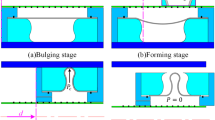Abstract
Reinforced s-shaped bellows is a kind of typical reinforced metal bellows that can withstand high pressure. Hydroforming process and its simulation technology of reinforced s-shaped bellows were investigated in this paper. The hydroforming technology of reinforced s-shaped bellows is a severe plastic deformation process. Most area of the bellows is in the state of severe plastic yielding with a maximum equivalent plastic strain of 30.6%. At the same time, the wall thickness shows a linear thinning trend from wave trough to peak. The control of hydraulic pressure is a key factor of hydroforming process. The best hydroforming hydraulic pressure is 12 MPa, which is in good agreement with the designed shape. At last, the key factors affecting plastic strain and wall thickness thinning of the hydroforming process were revealed. Plastic strain and wall thickness thinning of the large-pitch bellows in the hydroforming process are obviously higher than those of the small-pitch ones. The waveform parameters directly affect the hydroforming process. However, the influences of initial wall thickness and number of layers of the bellows were not obvious. The maximum thinning rate of the bellows basically maintains around 20%.
Similar content being viewed by others
References
Ramin H, Ghader F, Karen A, Ahmad FD (2010) Application of the hydroforming strain- and stress-limit diagrams to predict necking in metal bellows forming process. Int J Adv Manuf Technol 46:551–561
Peng HL, Zhang XL, Li ZQ (2015) Numerical simulation and experiment of bellows hydroforming. Space Manuf Technol 4(2):23–30
Asnafia N, Nilsson T, Lassl G (2003) Tubular hydroforming of automotive side members with extruded aluminium profile. J Mater Process Technol 142:93–101
Hartl C (2005) Research and advances in fundamentals and industrial applications of hydroforming. J Mater Process Technol 167(2-3):383–392
Zhan M, Shi F (2014) Forming mechanism and rules of mandreless neck-spinning on corrugated pipes. J Plast Eng 21(2):108–115
Chen MD, Hsu RQ, Fuh KH (2005) Effects of over-roll thickness on cone surface roughness in shear spinning. J Mater Process Technol 159:1–8
Li XQ, He DH (2013) Identification of material parameters from punch stretch test. Trans Nonferrous Metals Soc China 23(5):1435–1441
Shan YQ, Cui JJ, Wang T, Pang T (2016) Indentifying constitutive parameters of magnetic pulse bulging tube. Forg Stamp Technol 41(9):71–79
Zhang ZD, Wang GD, Chen CQ (2016) Numerical simulation of mechanical behavior of stack-welded bellow under cyclic tension and compression. J Vac Sci Technol 36(5):597–301
Pei HZ, Yin ZS, Zhang GL, Liu YY (2011) Research on Ni-P alloy electroless casting process for micro-bellows. Cast Forg Weld 40(21):170–172
Bakhshi JM, Elyasi M, Gorji A (2009) Numerical and experimental investigation of the effect of the pressure path on forming metallic bellows. J Eng Manuf 224:95–101
Lee SW (2002) Study on the forming parameters of the metal bellows. J Mater Process Technol 130-131(11):47–53
Wang G, Zhang KF, Wu DZ (2006) Superplastic forming of bellows expansion joints made of titanium alloy. J Mater Process Technol 178:24–28
Faraji G, Mosavi MM, Norouzifard V (2009) Evaluation of effective parameters in metal bellows process. J Mater Process Technol 209:3431–3437
Liu J, Liu Y, Li LY, Li X (2017) Springback behaviors of bi-layered non-homogeneous bellows in hydroforming. Int J Adv Manuf Technol 93:1605–1616
Xie WC, Teng BG, Yuan SJ (2015) Deformation analysis of hydro-bending of bi-layered metal tubes. Int J Adv Manuf Technol 79:211–219
Furushima T, Hung NQ, Manabe K, Sasaki O (2013) Development of semi-dieless metal bellows forming process. J Mater Process Technol 213:1406–1411
Manabe K, Amino M (2002) Effects of process parameters and material properties on deformation process in tube hydroforming. J Mater Process Technol 123:285–291
Liu J, Li HW, Liu Y, Li LY, Sun C (2018) "Size effect" related hydroforming characteristics of thin-walled 316-L bellow consider pressure change. Int J Adv Manuf Technol 98:505–522
Lang LH, Wang ZR, Kang DC (2004) Hydroforming highlights: sheet hydroforming and tube hydroforming. J Mater Process Technol 151(1-3):165–177
Funding
This study is supported by the National Nature Science Foundation of China (No. 51371146) and Natural Science Basic Research Plan in Shaanxi Province of China (No. 2018JQ1030).
Author information
Authors and Affiliations
Corresponding author
Additional information
Publisher’s note
Springer Nature remains neutral with regard to jurisdictional claims in published maps and institutional affiliations.
Rights and permissions
About this article
Cite this article
Yuan, Z., Huo, S., Ren, J. et al. Study on the hydroforming technology of reinforced s-shaped bellows. Int J Adv Manuf Technol 103, 2541–2552 (2019). https://doi.org/10.1007/s00170-019-03659-5
Received:
Accepted:
Published:
Issue Date:
DOI: https://doi.org/10.1007/s00170-019-03659-5



